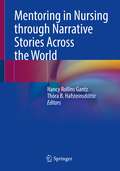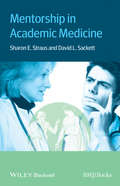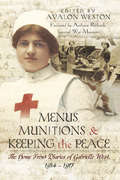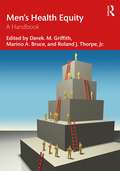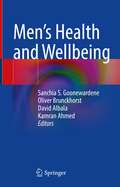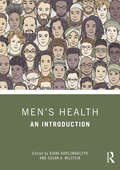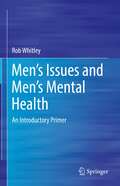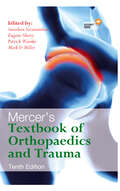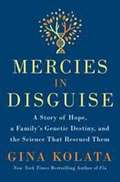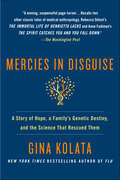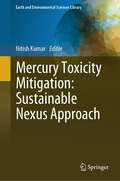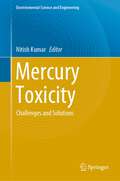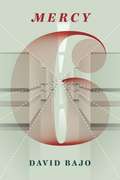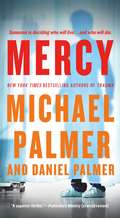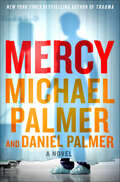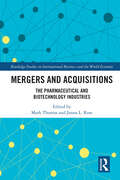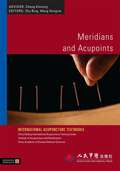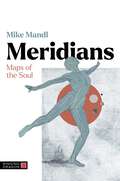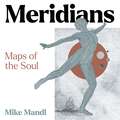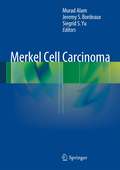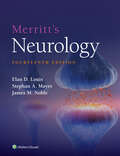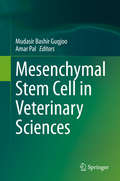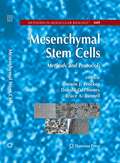- Table View
- List View
Mentoring in Nursing through Narrative Stories Across the World
by Thóra B. Hafsteinsdóttir Nancy Rollins GantzThe book explores how mentoring, theoretical background of mentoring and how mentoring is used by nurses in all arenas where they work in health care, education, research, policy, politics, and academia in supporting nurses with their professional and career development. Over 300 mentors and mentees, from a wide range of countries across all continents, share their stories of mentoring reflecting on their development in leadership, clinical practice, education, research and politics. The book describes various types of mentoring including more traditional types of mentoring as well as virtual, online and peer mentoring. During the mentorship trajectories the nurses address an inclusive collection of issues that they are faced with and share supporting strategies. The book highlights the importance of mentoring for nurses to support their personal, and professional leadership development. Also, it emphasizes the importance of mentoring for when nurses engaged in variety of projects that could entail or encompass evidence-based clinical practice, development within education, research in the clinical arena, policy formation, political affairs, or cultural inclusion that present significant impact in patient care and healthcare outcomes within and across countries. With The Future of Nursing 2020-2030: Charting a Path to Achieve Health Equity report from the National Academies of Sciences, published in 2021, the role of nursing will become ever more dynamic and therefore the profession of nursing must be visible in improving and securing the future for patients, families, and communities across the globe. Mentoring practices to build the profession’s leaders are forever essential, acute, and imperative.This book shows how mentoring can support nurses in further developing nursing as a profession and scientific discipline across countries to support clinical application of evidence based practice, and nursing education and research dissemination. Accordingly, this book shares essential, diverse and pioneering expertise through wide range of narrative stories that will benefit nurses at all years of experience, from early career nurses, emerging leaders, nurse educators, leaders, policy makers and nurse scientists around the globe. The nursing profession must magnify its position in health care and nurses need to proliferate their contributions throughout the globe. They can accomplish that through mentoring and “growing and nurturing other nurses” to advance and thrive in today’s world.
Mentorship in Academic Medicine
by Sharon Straus David SackettMentorship in Academic Medicine is an evidence-based guide for establishing and maintaining successful mentoring relationships for both mentors and mentees.Drawing upon the existing evidence-base on academic mentoring in medicine and the health sciences, it applies a case-stimulus learning approach to the common challenges and opportunities in mentorship in academic medicine. Each chapter begins with cases that take the reader into the evidence around specific issues in mentorship and provides actionable messages and recommendations for both correcting and preventing the problems presented in the cases. Accompanying the text is an interactive, online learning resource on mentorship. This e-tool provides updated resources for mentors and mentees, including video clips and podcasts with effective mentors who share their mentorship tips and strategies for effective mentorship. It also provides updated departmental and institutional strategies for establishing, running, and evaluating effective mentoring programs.Mentorship in Academic Medicine provides useful strategies and tactics for overcoming the common problems and flaws in mentoring programs and fostering productive and successful mentoring relationships and is a valuable guide for both mentors and mentees.
Menus, Munitions and Keeping the Peace: The Home Front Diaries of Gabrielle West 1914–1917
by Avalon WestonWhen Gabrielle West wrote diaries about her war to send to her much missed favorite brother in India she had no idea that a hundred years later they would be of interest to anyone.Soon after the outbreak of the First World War, Vicars daughter Gabrielle joined the Red Cross and worked as a volunteer cook in two army convalescent hospitals. She then secured paid positions in the canteens of the Farnborough Royal Aircraft Factory and then the Woolwich Arsenal, where she watched Zeppelin raids over London during her night shifts. Having failed a mental arithmetic test to drive a horse-drawn bread van for J. Lyons, she was among the first women enrolled in the police and spent the rest of the war looking after the girls in various munitions factories.Gabrielle wrote about and drew what she saw. She had no interest in opinion or politics. She took her bicycle and her dog Rip everywhere and they appear in many of her stories. She had a sharp eye and sometimes a sharp pen.At the end of the war she was simply sent home. She spent the rest of her life caring for relatives. She lived to 100 and never married. The First World War was her big adventure.These days, the reader might feel MI5 should worry about those detailed line drawings of the processes in the factories being sent by Royal Mail across the world but a hundred years ago?
Men’s Health Equity: A Handbook
by Marino A. Bruce Derek M. Griffith Roland J. Thorpe Jr.Worldwide, men have more opportunities, privileges, and power, yet they also have shorter life expectancies than women. Why is this? Why are there stark differences in the burden of disease, quality of life, and length of life amongst men, by race, ethnicity, (dis)ability status, sexual orientation, gender identity, rurality, and national context? Why is this a largely unexplored area of research? Men’s Health Equity is the first volume to describe men’s health equity as a field of study that emerged from gaps in and between research on men’s health and health inequities. This handbook provides a comprehensive review of foundations of the field; summarizes the issues unique to different populations; discusses key frameworks for studying and exploring issues that cut across populations in the United States, Australia, Canada, the United Kingdom, Central America, and South America; and offers strategies for improving the health of key population groups and achieving men’s health equity overall. This book systematically explores the underlying causes of these differences, describes the specific challenges faced by particular groups of men, and offers policy and programmatic strategies to improve the health and well-being of men and pursue men’s health equity. Men’s Health Equity will be the first collection to present the state of the science in this field, its progress, its breadth, and its future. This book is an invaluable resource for scholars, researchers, students, and professionals interested in men’s health equity, men’s health, psychology of men’s health, gender studies, public health, and global health.
Men’s Health and Wellbeing
by Kamran Ahmed Sanchia S. Goonewardene David Albala Oliver BrunckhorstThis book provides a concise overview of the latest controversies and advances in men’s health. It covers the male anatomy, physiology, and the metabolic syndromes that most commonly affect males. A range of benign and malignant conditions affecting the prostate, testes, rectum and colon are detailed. Chapters feature an easy-to-follow format and feature learning objectives to highlight the key concepts in each chapter aiding the reader to develop a thorough understanding of fundamental aspects in men’s health.Men’s Health and Wellbeing features insightful reviews of controversies and recent developments in men’s health, and is a valuable resource for all trainee and practicing medical professionals who treat these patients.
Men’s Health: An Introduction
by Diana And KarczmarczykThis comprehensive book addresses men’s health and wellness in the context of the male psyche, provides up to date research on men’s health, discusses theoretical frameworks, shares perspectives from men and lists consumer resources and tools. Men’s Health explores social, cultural, physical and psychological approaches to men’s health with sections focusing on the psycho-social issues, the body, relationships, healthy living and aging, while taking into account cultural differences. Each chapter: provides a review of the current science and emerging research of the topic; outlines theoretical frameworks, best practices and recommendations for advancing men’s health through service delivery, research, education, policy and advocacy; features a personal assessment tool on the topic; and includes vignettes from men, their friends and families, and care providers. Suitable for students taking undergraduate courses on men’s health and wellness, this broad-ranging textbook is the ideal introduction to the topic.
Men’s Issues and Men’s Mental Health: An Introductory Primer
by Rob WhitleyTraditionally, men’s mental health woes have been attributed to male stubbornness and rigid notions of masculinity. However, there is growing recognition that mental health issues in men are socially determined by a range of factors including family, educational, occupational, and legal issues. These and a variety of other social issues have been collectively labelled ‘men’s issues’ and are being increasingly linked to negative men’s mental health outcomes. This book gives an overview of men’s mental health as well as related men’s issues, adopting a public-health-inspired approach examining the research linking social exposures and mental health outcomes. The book is unique in that it synthesizes and explores men’s issues, men’s mental health, and social determinants in a holistic and integrated manner through assessment of the social scientific and psychiatric literature.In this book, the author discusses the social determinants of men’s mental health and accompanying psychosocial interventions, moving beyond one-dimensional discussions of masculinity. Among the topics covered are:The Social Determinants of Male SuicideAttention-Deficit/Hyperactivity Disorder in Young Males: The Medicalization of Boyhood?Why Do Men Have Low Rates of Formal Mental Health Service Utilization? An Analysis of Social and Systemic Barriers to Care, and Discussion of Promising Male-Friendly PracticesThe Gender Gap in Education: Understanding Educational Underachievement in Young Males and its Relationship to Adverse Mental HealthEmployment, Unemployment and Workplace Issues in Relation to Men’s Mental HealthMen’s Issues and Men’s Mental Health: An Introductory Primer is essential reading for healthcare practitioners and social service providers including psychiatrists, psychologists, social workers, occupational therapists, counsellors, teachers, charity workers, health promotion specialists, and public health officers. It is also a useful text for graduate and advanced undergraduate students in health care, social services, public health, epidemiology and social sciences, particularly sociology, psychology, and gender studies. Finally, the book can be read and understood by an intelligent lay reader, making it accessible for the wider public.
Mercer's Textbook of Orthopaedics and Trauma Tenth edition
by Eugene Sherry Patrick Warnke Mark D Miller Sureshan SivananthanHighly Commended, BMA Medical Book Awards 2013Orthopaedic problems account for over one-third of all medical and surgical problems. Mercer's Textbook of Orthopaedics and Trauma provides all the information required by the senior trainee or qualified specialist to improve understanding and management of any given condition or disease in this area.Si
Mercies In Disguise: A Story of Hope, A Family's Genetic Destiny, and the Science That Rescued Them
by Gina KolataIf your family carried a mutated gene that foretold brutal illness and you could find out if you inherited it, would you do it? Would you confront it, accepting whatever the answer was? Or ignore it while you could? In Mercies in Disguise, acclaimed New York Times reporter and best-selling author Gina Kolata tells the story of the Baxleys, an upstanding family in small-town South Carolina. Some family members were doctors; still, they are baffled by an inscrutable illness. Finally, after a remarkable sequence of providential events, they discover the cause of the disease. Science, meanwhile, progressing for fifty years along a parallel track, handed the Baxleys not a cure but the answer to a question--a blood test that would reveal who had the gene for the disease--and a dilemma: fertility specialists had created a way to spare the children. Mercies in Disguise tells the story of a family who took matters into their own hands when medicine could not help. It's a story of a family who must deal with unspeakable tragedy without being driven apart. And it's the story of a young woman--Amanda Baxley--who faced the future, determined to find a way to disrupt her destiny. GINA KOLATA is a writer and medical reporter for The New York Times. She has previously written five books and edited three collections of popular science writing. Ms. Kolata lives with her husband in Princeton, New Jersey.
Mercies in Disguise: A Story of Hope, a Family's Genetic Destiny, and the Science That Rescued Them
by Gina Kolata"[Kolata] is a gifted storyteller. Her account of the Baxleys... is both engrossing and distressing... Kolata's book raises crucial questions about knowledge that can be both vital and fatal, both pallative and dangerous." —Andrew Solomon, The New York Review of BooksNew York Times science reporter Gina Kolata follows a family through genetic illness and one courageous daughter who decides her fate shall no longer be decided by a genetic flaw.The phone rings. The doctor from California is on the line. “Are you ready Amanda?” The two people Amanda Baxley loves the most had begged her not to be tested—at least, not now. But she had to find out.If your family carried a mutated gene that foretold a brutal illness and you were offered the chance to find out if you’d inherited it, would you do it? Would you walk toward the problem, bravely accepting whatever answer came your way? Or would you avoid the potential bad news as long as possible? In Mercies in Disguise, acclaimed New York Times science reporter and bestselling author Gina Kolata tells the story of the Baxleys, an almost archetypal family in a small town in South Carolina. A proud and determined clan, many of them doctors, they are struck one by one with an inscrutable illness. They finally discover the cause of the disease after a remarkable sequence of events that many saw as providential. Meanwhile, science, progressing for a half a century along a parallel track, had handed the Baxleys a resolution—not a cure, but a blood test that would reveal who had the gene for the disease and who did not. And science would offer another dilemma—fertility specialists had created a way to spare the children through an expensive process. A work of narrative nonfiction, Mercies in Disguise is the story of a family that took matters into its own hands when the medical world abandoned them. It’s a story of a family that had to deal with unspeakable tragedy and yet did not allow it to tear them apart. And it is the story of a young woman—Amanda Baxley—who faced the future head on, determined to find a way to disrupt her family’s destiny.
Mercury Toxicity Mitigation: Sustainable Nexus Approach (Earth and Environmental Sciences Library)
by Nitish KumarMercury is a naturally occurring element that is toxic in nature. According to the US Environmental Protection Agency, the safe limit of mercury ion in drinking water is 10 nM to avoid the serious health problems to humans. Mercury is a pollutant of global concern. Both anthropogenic activities and natural processes cause its release into different spheres of the environment resulting in severe adverse impacts. Increased anthropogenic discharge of mercury leads to disturbance in its natural biogeochemical cycle which results in to unenviable diseases and hazardous health effects.This book will provide state-of-the-art information to the graduate students training in toxicology, risk assessors, researchers and medical providers at large. Many monographs, book chapters, contemporary reviews, and peer reviewed articles about mercury health impact are also available worldwide. However, there is no complete understanding available on toxicological studies of mercury, which covers the broader spectrum of findings that range from sources of exposure to mercury toxicity as well as its remediation strategies. It is aimed to bring the readers updated information about the sources of mercury contamination, and its impact on human health and on prospective mitigation strategies through multi-disciplinary approaches. The book contains three sections. First section describes the different sources and distribution of mercury in the environment. Second section explains the health risks linked to mercury poisoning. Third section addresses sustainable mercury toxicity mitigation strategies through multi-disciplinary approaches. The key topic of this book will cover following: •Source and distribution of mercury in the environment•Effects and responses of mercury toxicity in plants• Health risk linked to mercury poisoning• Sustainable mercury toxicity mitigation strategiesThis book is a valuable resource to students, academics, researchers, and environmental professionals doing field work on mercury contamination throughout the world.
Mercury Toxicity: Challenges and Solutions (Environmental Science and Engineering)
by Nitish KumarThis book presents mercury toxicity with respect to remediation and health issues. It covers sources of mercury contamination, its impact on human health, and prospective remediation by both bioremediation and phytoremediation with the application of recent advanced techniques such as genetic engineering and nanotechnology.Both anthropogenic activities and natural processes cause the release of mercury into different spheres of the environment resulting in severe adverse impacts. Increased anthropogenic discharge of mercury leads to disturbance in its natural biogeochemical cycle, which results in unenviable diseases and hazardous health effects. Mercury pollution is responsible for causing neurobehavioral, kidney, heart, gastrointestinal, liver, and other diseases. Many published works about the impact of mercury on health are also available worldwide; however, there is no complete understanding available on toxicological studies of mercury that covers the broader spectrum of findings ranging from sources of exposure to mercury toxicity to its remediation strategies.This book brings together a diverse group of environmental science, sustainability, and health researchers to address the challenges posed by global mass poisoning caused by mercury contamination. The book also proposes solutions to contamination through multi-disciplinary approaches.The book contains three sections. The first part describes the different sources and distribution of mercury in soil and plant ecosystems. The second part explains the health risks linked to mercury toxicity. The third part addresses sustainable mercury toxicity mitigation strategies and the potential applications of recent technology in providing solutions. This book is a valuable resource to students, academics, researchers, and environmental professionals working in the field of mercury contamination.
Mercury, Mining, and Empire: The Human and Ecological Cost of Colonial Silver Mining in the Andes
by Nicholas A. RobinsOn the basis of an examination of the colonial mercury and silver production processes and related labor systems, Mercury, Mining, and Empire explores the effects of mercury pollution in colonial Huancavelica, Peru, and Potosí, in present-day Bolivia. The book presents a multifaceted and interwoven tale of what colonial exploitation of indigenous peoples and resources left in its wake. It is a socio-ecological history that explores the toxic interrelationships between mercury and silver production, urban environments, and the people who lived and worked in them. Nicholas A. Robins tells the story of how native peoples in the region were conscripted into the noxious ranks of foot soldiers of proto-globalism, and how their fate, and that of their communities, was—and still is—chained to it.
Mercy 6
by David BajoIn Mercy 6, David Bajo’s courageous new medical thriller, four people collapse dead in the same instant within a newly renovated Los Angeles hospital. Dr. Mendenhall, the woman who is head of the emergency room, isn't convinced the cause of death is a contagion. But it's in the interests of the hospital administrators - and of the world at large - for people to think that it is. If the world knew the truth there could only be widespread panic. The hospital is immediately locked down. Information is suddenly being strictly controlled. Government troops encircle the hospital to enforce the quarantine, and other bodies arrive in ER. Working with an ally in pathology and a colleague outside the hospital, Mendenhall develops her understanding that what has taken these lives has global implications . . . and whatever it is, it’s not a virus.
Mercy: A Novel
by Michael Palmer Daniel PalmerMercy: What's your definition? Dr. Julie Devereux is an outspoken advocate for the right to die--until a motorcycle accident leaves her fianc#65533;, Sam Talbot, a quadriplegic. Sam begs to end his life, but Julie sees hope in a life together. Then, just as Sam seems to be coming around to her point of view, he has an unexpected heart attack. An autopsy reveals that Sam died of an unusual heart defect, one seen only in those under extreme stress--in fact, it appears that Sam had literally been scared to death. As Julie investigates similar cases, she finds a frightening pattern. . . and finds herself the target of disturbing threats. The more cases Julie discovers, the more the threats escalate, until she is accused of a mercy killing of her own. Now, to clear her name and save her career, she must track down whoever is behind these mysterious deaths. . . but time is running out, as someone has decided that killing Julie is the only way to stop her. This edition of the book is the deluxe, tall rack mass market paperback.
Mercy: A Novel
by Michael Palmer Daniel PalmerA doctor uncovers a series of suspicious deaths that may be someone’s twisted idea of mercy in this “superior thriller” from the New York Times–bestselling author’s (Publishers Weekly, starred review).Dr. Julie Devereux is an outspoken advocate for the right to die—until a motorcycle accident leaves her fiancé, Sam, a quadriplegic. Sam begs to end his life, but Julie sees hope in a life together. When he suddenly dies from an unexpected heart attack, an autopsy reveals an unusual heart defect, one only seen in individuals under extreme stress. It appears that Sam was literally scared to death.As Julie investigates similar cases, she finds a frightening pattern . . . and finds herself the target of disturbing threats. She is determined to track down whoever is behind these mysterious deaths, but time is running out as someone has decided that killing Julie is the only way to stop her.
Mergers and Acquisitions: The Pharmaceutical and Biotechnology Industries (Routledge Studies in International Business and the World Economy)
by Mark Thomas Janna L. RoseCovid-19 has brought so much uncertainty, but one certainty is that the vaccine race will generate winners and losers in the pharmaceutical and biotechnology industries. This will have a major impact on merger and acquisition activity. While the plethora of merger and acquisition deals are abundantly reported by the news media, there is a clear lack of in-depth analysis on the multiple rationales and various challenges in the life sciences industry. By offering contributions from a variety of experts in the biotechnology and pharmaceutical industries, as well as experts on mergers and acquisitions, this edited collection will draw upon the knowledge of a variety of different actors within the fields of pharma and biotech. This book offers a timely exploration of the complexities of mergers and acquisitions in the pharmaceutical and biotechnology industries while seeking to bridge the gap between theory and practice. It presents a critical analysis of the rationale for acquisitions and studies the challenges of ensuring a successful deal. In the light of the Covid-19 pandemic, it will also explore the impact this may have on the industry, which may further stimulate merger and acquisition activity. It will be of interest to researchers, academics, policymakers, and students in the fields of strategy, management, governance, and the biotechnology and pharmaceutical industries.
Meridians and Acupoints
by Hongcai Wang Bing ZhuAn in-depth understanding of the meridians and acupoints lies at the heart of effective practice in traditional Chinese medicine. This book outlines everything that practitioners and students need to know. The book explains how meridians relate to the major organs, where they are located in the body, and how they are linked to the healthy flow of Qi and blood. A large section of the book is devoted to descriptions of specific acupoints - their names, how to locate them, an introduction to the symptoms they can be used to treat, and how. Also included is a thorough introduction to the basics of acupuncture practice, including how to prepare a patient prior to treatment, how to insert and manipulate acupuncture needles, how and when to use moxibustion and cupping techniques, and what to do if treatment goes wrong. This useful and authoritative textbook, compiled by the China Beijing International Acupuncture Training Centre (CBIATC), under the editorial direction of leading Chinese clinicians Zhu Bing and Wang Hongcai, is essential reading for students of traditional Chinese medicine, and an excellent reference for acupuncture practitioners at all levels.
Meridians: Maps of the Soul
by Mike MandlMeridians are the bridge between the psyche and soma, the system that allows our life force to flow through our body. Each of the twelve main meridians stand for a fundamental life principle and by examining them, we can begin a journey towards better health- as well as freedom and contentment.In this inspirational, easy-to-read deep dive, Mike Mandl uses his own wit and humour to explore the life principles of the meridians and offers a toolbox for self-diagnostic purposes, demonstrating how to strengthen these principles, correct imbalances, and keep in harmony with yourself through daily observation and maintenance.Translating the principles of Traditional Chinese Medicine into an engaging, accessible resource for practitioners and novices alike, this is the perfect first step in harnessing the meridians for your own self-actualisation.
Meridians: Maps of the Soul
by Mike MandlAn accessible explanation of the essence of TCM and Meridians.Meridians are the bridge between the psyche and soma, the system that allows our life force to flow through our body. Each of the twelve main meridians stand for a fundamental life principle and by examining them, we can begin a journey towards better health- as well as freedom and contentment.In this inspirational, easy-to-read deep dive, Mike Mandl uses his own wit and humour to explore the life principles of the meridians and offers a toolbox for self-diagnostic purposes, demonstrating how to strengthen these principles, correct imbalances, and keep in harmony with yourself through daily observation and maintenance.Translating the principles of Traditional Chinese Medicine into an engaging, accessible resource for practitioners and novices alike, this is the perfect first step in harnessing the meridians for your own self-actualisation.(P)2023 Hodder & Stoughton Limited
Merkel Cell Carcinoma
by Murad Alam Siegrid S. Yu Jeremy S. BordeauxMerkel Cell Carcinoma is one of the first comprehensive, single-source clinical texts on the subject. Although not as common as melanoma, Merkel cell carcinoma is not rare - and it is both more deadly than melanoma and increasing at an epidemic rate. The book is clinical in focus and emphasizes treatment of this poorly understood cancer. Contributing authors include dermatologists, surgical oncologists, radiation oncologists, and medical oncologists from the US and around the world. Features: · Comprehensive single-source clinical reference · Treatment focus · Written for practitioners, with emphasis on clinical relevance and quick retrieval of information · Contributing authors represent all disciplines involved in treatment of Merkel cell carcinoma: dermatology, surgical oncology, radiation oncology, and medical oncology · International in perspective, with contributors from US and abroad · Members of active Merkel Cell Carcinoma Multicenter Interest Group have authored some of the chapters
Merritt’s Neurology
by Elan D Louis Stephan A MayerFor more than 60 years, Merritt’s Neurology has remained a trusted landmark text in clinical neurology, providing unparalleled guidance on neurologic protocols, treatment guidelines, clinical pathways, therapeutic recommendations, and imaging. The fourteenth edition reflects the state of today’s practice, with fully updated content and timely new sections and chapters. With this edition, Dr. James Noble joins Drs. Elan Louis and Stephan A. Mayer as co-editor, all of whom trained at Columbia University where Dr. H. Houston Merritt wrote the initial editions of this book. Lauded for its comprehensive coverage, colorful and dynamic visual style, readability, and ease of use, this up-to-date reference is ideal for neurologists, primary care physicians, and residents alike.
Mesenchymal Stem Cell in Veterinary Sciences
by Mudasir Bashir Gugjoo Amar PalThis book focuses on mesenchymal stem cells (MSCs) of animal origin, including their isolation, characterization, and clinical applications. After briefly discussing the historical development of the field of stem cell research, it describes the basic properties and nature of stem cells particularly in relation to MSCs. In turn, it reviews materials and methods used to isolate MSCs from various sources, culture expansion, characterization and long-term storage. It also explores the therapeutic efficacy, immunomodulation and anti-inflammatory, and differentiation properties of MSCs. Importantly, the book discusses the applications of genetic engineering to enhance the efficacy and potential of MSCs in regenerative medicine. The book largely addresses the potential applications of mesenchymal stem cells in therapies for important species of domesticated animals including sheep, goats, cattle, buffalo, cats, dogs and horses. Finally, the book presents an abridgement of challenges and future prospects of stem cell research and application in medicine, in general and veterinary sciences, in particular.
Mesenchymal Stem Cells
by Darwin J. Prockop Bruce A. Bunnell Donald G. PhinneyFor over forty years, mesenchymal stem cells (MSCs) have been scrutinized and studied, garnering much attention due to their broad therapeutic efficacy. In this essential book, leaders in the field were assembled to contribute detailed methodologies for the isolation and characterization of human and rodent MSCs. Cutting edge and easy to use, this book is the perfect resource for scientists attempting to pursue this important and ever-developing field of research.
Mesenchymal Stem Cells
by Massimiliano GnecchiThis volume aims to outline the current status of the Mesenchymal Stem Cells(MSC) field in regenerative medicine and to propose clear and reproducible protocols to better define the identity, function and use of these cells that are today, more than ever, "under the spotlight". Mesenchymal Stem Cells: Methods and Protocols, Second Edition is organized into four sections. The first guides the reader through a series of state-of-the-art reviews summarizing the use of MSC for the treatment of various diseases. The other three sections are a collection of methodological chapters covering several aspects: isolation and characterization of MSC; expansion of MSC for clinical use; production and characterization of the MSC secretome. Written in the highly successful Methods in Molecular Biology series format, the method chapters include introductions to their respective topics, complete lists of the necessary materials and reagents, step-by-step, readily reproducible laboratory protocols, and tips on troubleshooting which will help the researcher to avoid known pitfalls. Authoritative and cutting-edge, Mesenchymal Stem Cells: Methods and Protocols, Second Edition, aims to ensure successful results in the further study of this vital field.
